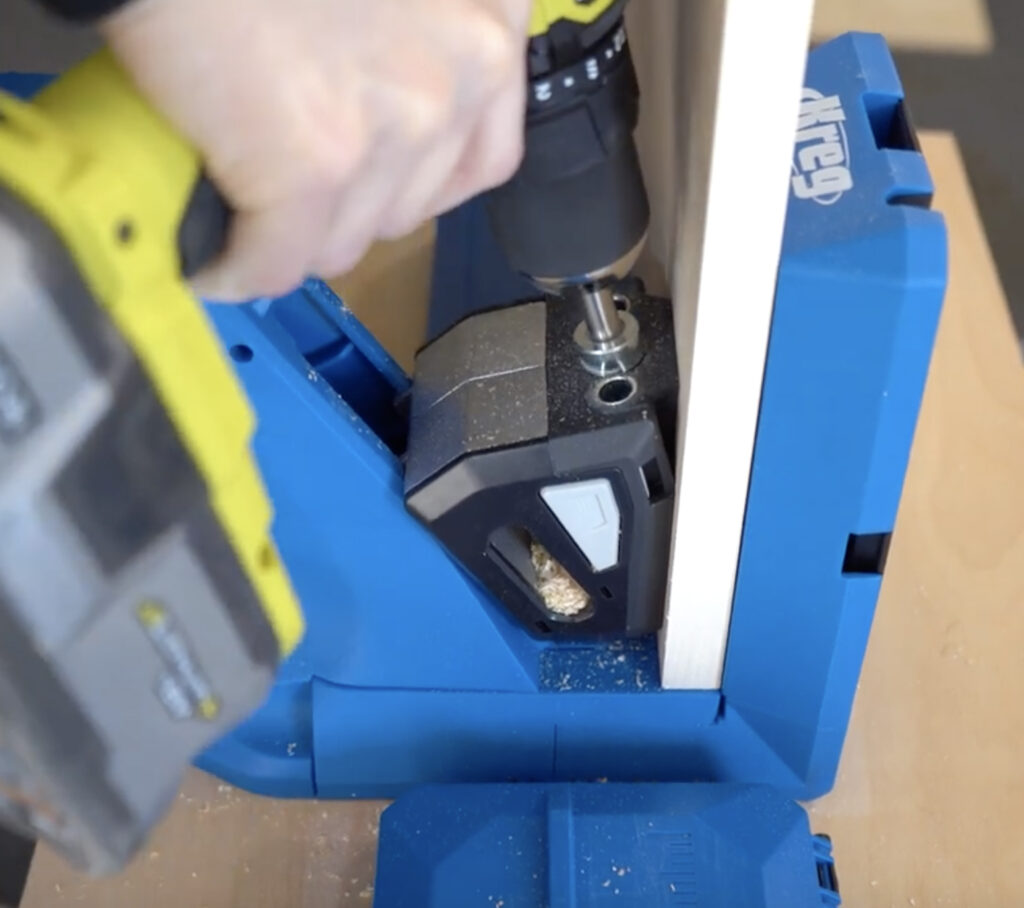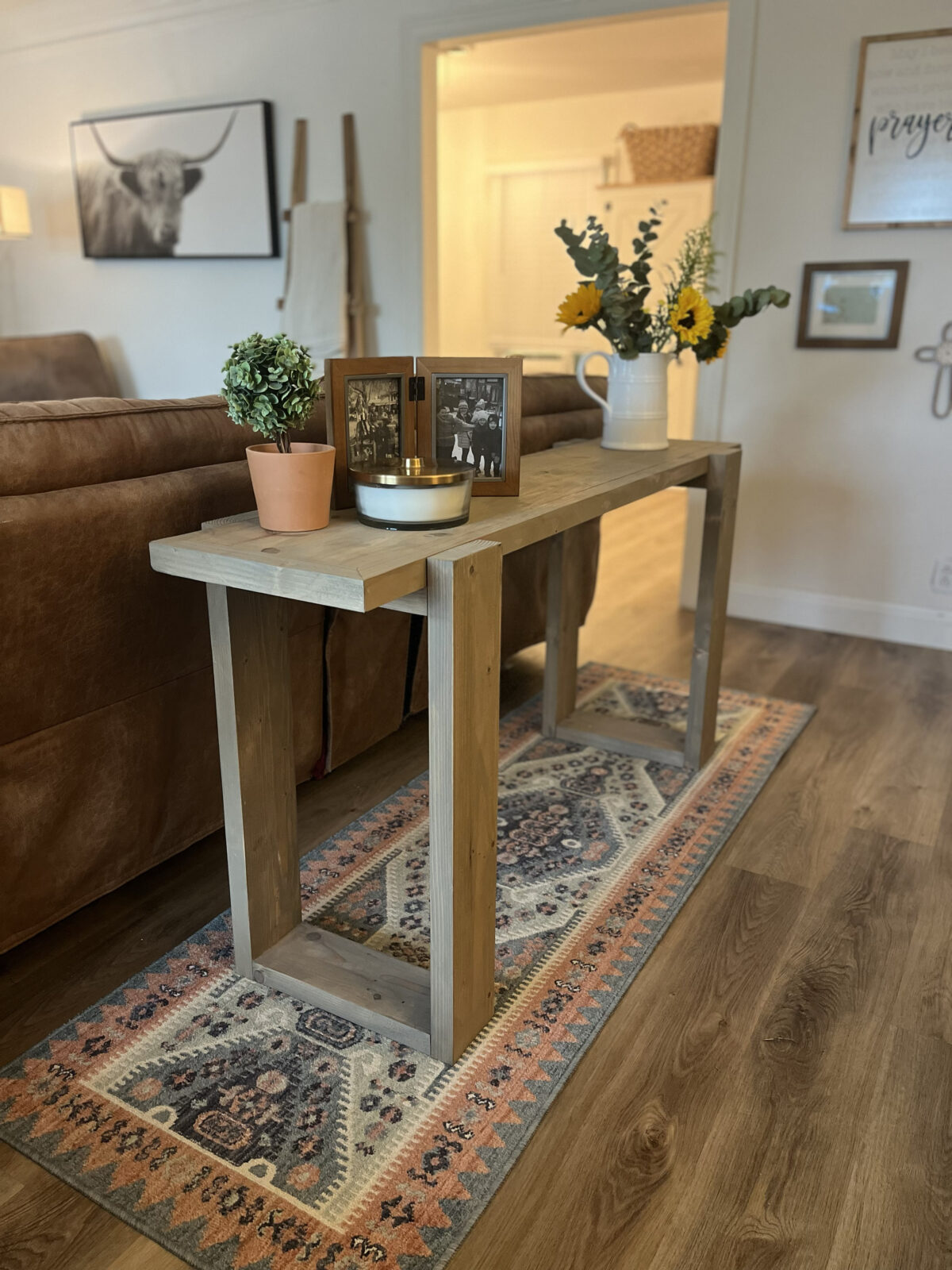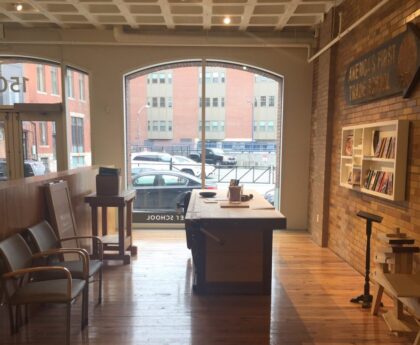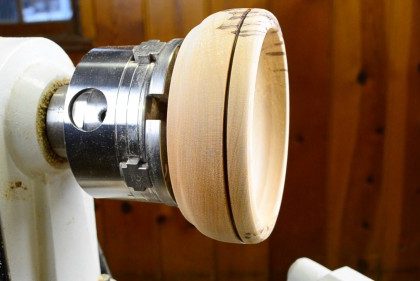Learn how to create your own DIY console table with these simple step-by-step instructions. Save money and add a personalized touch to your home decor with this fun and easy project.
After you watch our how-to video be sure to download and print the free plans for this table at the bottom of this post! I love how this table turned out so much and I love that we were able to build it for under $60 in lumber!
Materials
The bulk of this table uses 2×6 framing lumber that we ripped to 5″ wide each. The top of the table uses a 12″ x 72″ edge-glued panel. You can use a different type of wood if the works better for you! I found my edge glued panel at Lowe’s and you can see that one HERE.
Kreg Jig
One question we get asked consistently is… “What is a Kreg Jig?” A Kreg Jig is a pocket hole jig that helps create pocket holes, allowing you to build with super strong joints. It makes joining two boards faster and gives you stronger and cleaner joints than countersinking a wood screw. We discovered them shortly after we started building furniture and it was a HUGE game changer for our furniture building! We were so impressed with how user-friendly they are and the strong joints it gave our builds! For this coffee table, I used my Kreg Jig 720 PRO and I LOVE IT! You guys will love it too… definitely worth the upgrade for those of you that already own a different model. You can see it HERE on Amazon! You can also check out our video on how to use it HERE!

Ripping the boards
Before adding any pocket holes, I ripped my 2×4 boards down to 5″ wide each. I like to make my cross cuts first with my miter saw, and then rip those smaller cuts with the table saw. We use our table saw to rip the round edges off of the framing boards we build with. This is an optional step but we like to do it to make the pieces of furniture look more expensive and not built with framing lumber. It really helps on a build like this table. Ripping them down gives the stacked boards a solid clean look, like it’s one piece. You can see how we rip our boards HERE!
Step 1 – Build the leg assemblies
First you will build 2 identical leg assemblies. These are 2×6 boards we ripped to 5” wide each. Add 1.5” pocket holes to each of your shorter 13.5” boards using a Kreg Jig with your drill. Attach the shorter boards to the longer boards using wood glue and 2.5” pocket hole screws. The bottom board will be flush with the bottom of the longer boards and the top board will be placed 1.5” from the top of the the longer boards.



Step 2 – Connect the leg bases
Next, attach the leg assemblies with the 40” long support board. This is also a 2×6 ripped to 5” wide.
Add 1.5” pocket holes to each end of the 40” board with a Kreg Jig. Attach them to the leg assemblies using wood glue and 2.5” pocket hole screws. Make sure to line up the 40” board in the center of each
leg assembly.


Step 3 – Build the table top
The table top is constructed with one 12” edge-glued panel trimmed with 2×6 ripped to 1.5” wide each. Begin by adding 3/4” pocket holes around all edges of the panel.


Step 4 – Trim the table top
The trim boards are ripped to 1.5” each. Cut each piece of lumber to size and miter each end to 45º. Attach the trim boards using wood glue and 1.25” pocket hole screws.



Step 5 – Attach the table top to the base
The final step is attaching the table top to the base assembly.
Lay the table top upside-down and place the base assembly upside-down on
top of the table top. Attach the base assembly with 2” pocket hole screws through the edges of the shorter leg pieces and into the trim of the table top. We used our Kreg Quick-Flip for this part!


Kreg Quick-Flip
Once the base was complete, we used the Kreg Quick-Flip to attach the base to the table top. This is such a fun tool! I use it all the time for different purchases. Drill a pilot hole and counterbore with one side, then drive a Kreg Screw with the #2 square-drive bit on the other side. You just quickly flip it and you are ready to insert the screw. It gives the joinery a very professional and hidden finish. You can see it HERE on Amazon!



Staining the Coffee Table
Before staining the console table, I used my sander to lightly sand the entire table. I like to start with 120 grit sandpaper and then move to 220 grit to get a smooth finish.
I used three different Varathane stain colors to create this. I started with an empty tub from the hardware store. These are super inexpensive. You can also use any empty container you have at home! I mixed two parts of Natural stain, one part of Golden Oak, and a splash of Weathered Gray. This gave me the perfect finish that I was looking for. You just put all of that into the bucket and stir it up just a bit and you’re ready to go!
Make sure to sand all the surfaces with medium and fine sandpaper to get an even, beautiful finish. I like to use my Ryobi Corner Cat for this! An orbital sander also works great!
I often get asked what protective coat I like to use on top. My favorite polyurethane is THIS ONE!

Console Table Plans
Be sure to check out some of our other free console table plans! Here are just a few!

DIY Modern Farmhouse Console Table


All finished!
I love the extra storage a console table gives you! They are so great for any room including the dining room or in the living room as a sofa table! I love how this one turned out!
DIY Console Table Plan

DIY Console Table
- 1 12″ x 72″ edge glued panel
- 4 2 x 6 x 8 framing lumber ripped to 5″ each
- several Kreg pocket hole screws 1.25″ and 2.5″




